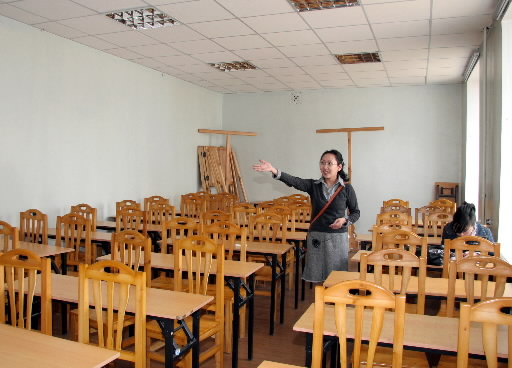Nuclear weapons can be eliminated: Chapter 3, Part 4
Jun. 22, 2009
Chapter 3: Mongolia's challenge
Part 4: Hiroshima Room
by Keisuke Yoshihara, Staff Writer
NGO establishes room for A-bomb exhibit at university
The National University of Mongolia, in the capital of Ulaanbaatar, has a room called the “Hiroshima Room.” It is located on the third floor of one of the school buildings. Visiting the room one Sunday, I found a girl studying by herself.
I spoke to her in Japanese, but was unable to communicate with her. Batjantsan Khishigdelger, 33, a lecturer in the Japanese Language Department, who served as my guide, explained, “She’s probably in a different department. She’s studying here because it’s warm.”
The sign on the door was written in English and noted that the room was established with the cooperation of a Hiroshima-based NGO called the “Asian Flower Bouquet.” A message from Hiroshima Mayor Tadatoshi Akiba was also placed on the wall near the blackboard.
The Hiroshima Room was established in June 2005. Junko Ogawa, 64, representative of the “Asian Flower Bouquet,” proposed the idea to the university. The NGO had maintained grassroots exchange programs with the people of Mongolia for ten years, and held A-bomb exhibitions whenever they visited Mongolia. They shouldered the expense of 300,000 yen to renovate a classroom to serve as the exhibit space.
In the deep of winter the temperature in Mongolia drops to minus 40 degrees Celsius so the NGO changed the window casings. They also replaced the lights. The group exhibited such artifacts as a photograph of the rising mushroom cloud and drawings made by A-bomb survivors depicting the devastation wrought by the atomic bombing of Hiroshima. They also displayed traditional Japanese items, like kimono, to introduce Japanese culture.
However, after about a year, the exhibited items were put into storage. Since then, they are displayed in the room only a few times a year. The university reportedly discontinued the permanent exhibit on the grounds that “the exhibit isn’t favorable to the mental health of the students” and “there are not enough available classrooms.”
“I had hoped the people of Mongolia, a nation rich in uranium, could be made aware of the horror of radiation,” said Ms. Ogawa. “In particular, I want the young people to recognize the danger, as they represent the future of the nation.”
“Students come to this university from all over Mongolia,” added Ms. Khishigdelger, “so it’s possible this information can spread throughout the country. I do my best to see that at least a few artifacts are still displayed in the room.”
I met one student who is trying to help convey the story of Hiroshima’s devastation. Bwaatar Nomundari, 22, is in her fifth year at the National Medical University of Mongolia. Ms. Nomundari studied for one year from the spring of 2003 at Sanyo Girls’ Senior High School, located in the suburbs of Hiroshima City. She is assisting with an A-bomb exhibit to be held by Ms. Ogawa and other members of her group at five locations in Ulaanbaatar this September.
“I knew that an atomic bomb was dropped on Hiroshima, and I heard the story of Sadako Sasaki and her paper cranes through a television program. But the photos of A-bomb survivors I saw in Hiroshima were more dreadful than I had imagined. At that point I realized that I had had only superficial knowledge of Hiroshima and I hadn’t really understood Hiroshima at all,” said Ms. Nomundari.
As a budding doctor, Ms. Nomundari believes she must help confront the effects of radiation on the human body.
(Originally published on June 5, 2009)
To comment on this article, please click the link below. Comments will be moderated and posted in a timely fashion. Comments may also appear in the Chugoku Shimbun newspaper.








